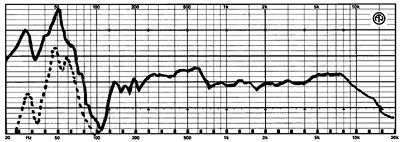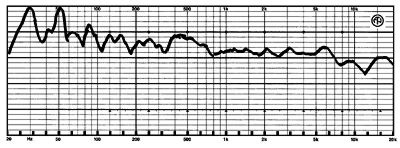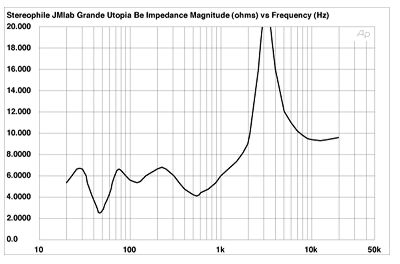| Columns Retired Columns & Blogs |
Focal-JMlab Grande Utopia Be loudspeaker Measurements
Sidebar 2: Measurements
The enormous weight of the Grande Utopia Be makes it difficult to move around, so the decision was made early on to bypass Stereophile's usual speaker-measurement regime and rely instead on the in-room, averaged-response technique I've been using for the last 15 years.
Such an approach can never provide "absolute" data about a speaker's performance, because it measures only the combination of speakers and room. However, it can be argued that this technique is actually more meaningful in terms of the actual listening experience. I've tested hundreds of different speakers this way, and the results invariably show very good correlation between the measured and the subjectively perceived frequency balance of a specific loudspeaker.
While the balance is by no means the only important factor in defining a speaker's performance, it is a very significant one. The in-room balance of a given speaker is like a fingerprint—distinct to that loudspeaker, that room, and the siting therein—and always says much about the overall character of the sonic presentation. Without defining the in-room balance, it's very easy to be "fooled" by minor anomalies that can make the speaker sound artificially attractive (or unattractive). Once the room response properly defined, it becomes much easier to dig below the surface to discover the underlying qualities.
That was particularly true for the Grande Utopia Be, a fine loudspeaker hampered by serious room-interaction difficulties when logically positioned in my 14' by 8.5' by 18' room. My traces (fig.1) show a midband sensitivity of 90-91dB/2.83V (close enough to the specified 92dB), but against that datum, the low and midbass (20-70Hz) averages +5dB, with the 50Hz room-mode peak at +12dB. Further up the band, however, a deep -10dB suckout from 80 to 120Hz is likely to have much more serious subjective consequences.

Fig.1 Focal-JMlab Grande Utopia Be, spatially averaged, 1/3-octave response in PM's listening room (5dB/vertical div., baseline of graph is 78dB spl). Dashed trace shows response with the 15" subwoofer disconnected.
Since this is nowhere near the bass/mid crossover point of 250Hz, nor is it a function of the twin bass drivers—the effect remained the same with the larger, lower bass driver disconnected (fig.1, dashed trace)—it might well be a consequence of placing the main bass driver so high off the ground. I encountered something similar a few years ago with PMC's MB1 professional monitor (fig.2), a very large stand-mount design with a transmission-line termination high off the ground. However, some obvious exceptions leave this supposition unproven. B&W's Nautilus N800 (fig.3) showed a trend not unlike the GUBe's, yet its twin bass drivers are quite close to the floor. And one of the two bass drivers of Neat's 5'-tall Ultimatum MF9 (fig.4) is well above seated head height, yet paradoxically, this speaker delivered one of the smoothest in-room balances through the bass region I've ever measured.

Fig.2 PMC MB-1, spatially averaged, 1/3-octave response in PM's listening room. (5dB/vertical div., baseline of graph is 73dB spl)

Fig.3 B&W Nautilus 800, spatially averaged, 1/3-octave response in PM's listening room. (5dB/vertical div., baseline of graph is 73dB spl)

Fig.4 Neat's Ultimatum, spatially averaged, 1/3-octave response in PM's listening room. (5dB/vertical div., baseline of graph is 73dB spl)
The Grande Utopia Be's output rises smoothly and gently by about 3dB between 120 and 500Hz, then falls back by a similar amount en route to 1.8kHz. The broad two-octave presence region, 1-4kHz, is smooth and slightly restrained, while the treble proper shows some increase, to a +2dB prominence centered on 6kHz. Fig.5, by the way, shows the exemplary in-room response of JBL's K2.

Fig.5 JBL K2, spatially averaged, 1/3-octave response in PM's listening room. (5dB/vertical div., baseline of graph is 73dB spl)
The Be's sensitivity might be quite generous, but the impedance trace (fig.6) shows that the speaker is a demanding load, dipping under 3 ohms at just below 50Hz. There's a zone at around 4 ohms either side of 500Hz, but elsewhere the load is an easy-to-drive 6 ohms or better.—Paul Messenger

Fig.6 Focal-JMlab Grande Utopia Be, electrical impedance (solid) and phase (dashed). (2 ohms/vertical div.)
- Log in or register to post comments




































